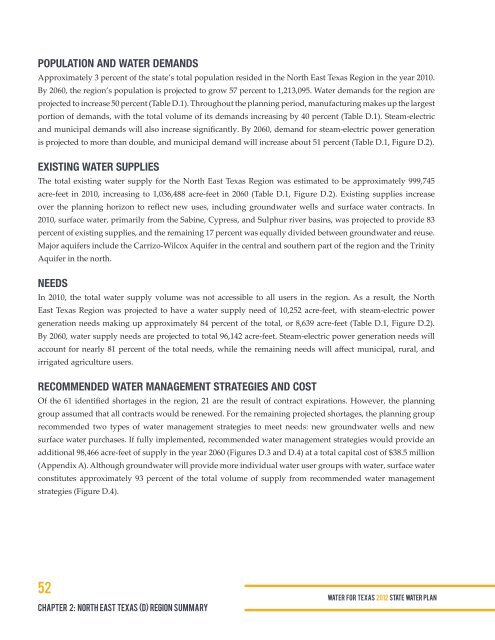Chapter 2 Regional Summaries - Texas Water Development Board
Chapter 2 Regional Summaries - Texas Water Development Board
Chapter 2 Regional Summaries - Texas Water Development Board
You also want an ePaper? Increase the reach of your titles
YUMPU automatically turns print PDFs into web optimized ePapers that Google loves.
POPULATION AND WATER DEMANDS<br />
Approximately 3 percent of the state’s total population resided in the North East <strong>Texas</strong> Region in the year 2010.<br />
By 2060, the region’s population is projected to grow 57 percent to 1,213,095. <strong>Water</strong> demands for the region are<br />
projected to increase 50 percent (Table D.1). Throughout the planning period, manufacturing makes up the largest<br />
portion of demands, with the total volume of its demands increasing by 40 percent (Table D.1). Steam-electric<br />
and municipal demands will also increase significantly. By 2060, demand for steam-electric power generation<br />
is projected to more than double, and municipal demand will increase about 51 percent (Table D.1, Figure D.2).<br />
EXISTING WATER SUPPLIES<br />
The total existing water supply for the North East <strong>Texas</strong> Region was estimated to be approximately 999,745<br />
acre-feet in 2010, increasing to 1,036,488 acre-feet in 2060 (Table D.1, Figure D.2). Existing supplies increase<br />
over the planning horizon to reflect new uses, including groundwater wells and surface water contracts. In<br />
2010, surface water, primarily from the Sabine, Cypress, and Sulphur river basins, was projected to provide 83<br />
percent of existing supplies, and the remaining 17 percent was equally divided between groundwater and reuse.<br />
Major aquifers include the Carrizo-Wilcox Aquifer in the central and southern part of the region and the Trinity<br />
Aquifer in the north.<br />
NEEDS<br />
In 2010, the total water supply volume was not accessible to all users in the region. As a result, the North<br />
East <strong>Texas</strong> Region was projected to have a water supply need of 10,252 acre-feet, with steam-electric power<br />
generation needs making up approximately 84 percent of the total, or 8,639 acre-feet (Table D.1, Figure D.2).<br />
By 2060, water supply needs are projected to total 96,142 acre-feet. Steam-electric power generation needs will<br />
account for nearly 81 percent of the total needs, while the remaining needs will affect municipal, rural, and<br />
irrigated agriculture users.<br />
RECOMMENDED WATER MANAGEMENT STRATEGIES AND COST<br />
Of the 61 identified shortages in the region, 21 are the result of contract expirations. However, the planning<br />
group assumed that all contracts would be renewed. For the remaining projected shortages, the planning group<br />
recommended two types of water management strategies to meet needs: new groundwater wells and new<br />
surface water purchases. If fully implemented, recommended water management strategies would provide an<br />
additional 98,466 acre-feet of supply in the year 2060 (Figures D.3 and D.4) at a total capital cost of $38.5 million<br />
(Appendix A). Although groundwater will provide more individual water user groups with water, surface water<br />
constitutes approximately 93 percent of the total volume of supply from recommended water management<br />
strategies (Figure D.4).<br />
52<br />
<strong>Chapter</strong> 2: North East <strong>Texas</strong> (D) Region s u m m a ry<br />
WAT E R FOR TEXAS 2012 STATE WATER PLAN
















